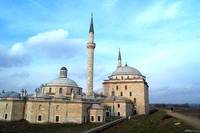Edirne, which stands on the Turkish border with Greece and Bulgaria, has seen extraordinary highs and lows during its history. As the Roman Adrianople, it stood close to the site of one of the most disastrous battles in history, when the Roman emperor Valens and most of his army was annihilated in AD 378. In 1205, just after they had taken Constantinople, the Crusaders were defeated here by the Bulgarians. In 1365 the Ottoman Sultan Murat I captured the city and made it the capital of his empire—until his successors finally took Constantinople itself in 1453. Edirne suffered appallingly in the Balkan Wars of the early 20th century. At one point, 20,000 Ottoman troops were marooned on an island and starved to death while thousands of civilians died in the city itself.

Times are quieter now. The Treaty of Lausanne of 1922 ensured that the city remained firmly inside Turkey. Today Edirne is worth visiting for its two 15th-century mosques and the wonderful Selimiye Mosque, built in the 1570s by Sinan (1489–1588), the greatest Ottoman architect of them all. It was completed when Sinan was in his eighties and is now a World Heritage Centre, even though, at three hours driving from Istanbul, it is still little visited. The city is also famous for its special fried liver—the main dish at any restaurant and apparently impossible to recreate anywhere else!
Almost as impressive as the Selimiye Mosque is the Medical Complex built by Sultan Beyazit II, the son of Murat I, just outside the city. It was completed in 1484 and was still functioning as a hospital until as late as 1916. Now beautifully restored to its original state and resplendent with its multiple domes and its mosque, the complex was opened to the public in 2008. Even before this it had won awards from the Council of Europe.
The hospital could take 32 patients at a time, housed in ten rooms, but in the first courtyard were treatment rooms for outpatients. The central room of the hospital has a fine dome: the treatment of mental cases in particular placed great emphasis on soothing surroundings. The hospital had a ten-piece orchestra with a repertoire designed to calm or stimulate according to the patients’ state of mind of the patients. Water, too, was considered to be calming, so the fountains were an important part of the ambience.
Alongside the hospital was the Medical School, with room for eighteen students. The hospital was well endowed with income from the local market dues, which meant that treatment was free and that the students were even paid for their attendance. The exhibit includes re-created displays of teaching and treatment sessions with illustrations of some of the procedures. Resolving back pain seems to have been a priority, as patients are shown tied up and being yanked about by 15th-century physios. Other treatments, one of them involving a cockerel, were perhaps less likely to succeed.
Until I had seen this wonderful museum I had been hesitant about bringing a group three hours out of Istanbul across a dull stretch of countryside. The Selimiye Mosque was perhaps enough of a draw in itself, but it is the Health Museum that made it a must. Adding the resplendent 19th-century Railway Station, now home of the History of Art Faculty of Edirne University—you approach the porter’s lodge through the original glass front of the booking office—and the recent, impressive, monument to the Treaty of Lausanne, plus a concluding cup of tea by the 16th-century bridge makes an excellent day out. Who knows, I may even get my group to tuck into the fried liver!
by Charles Freeman. Charles will be leading a tour of Istanbul and Edirne for Ciceroni Tours from 2nd–8th October.






